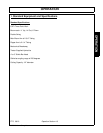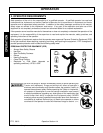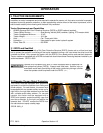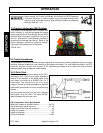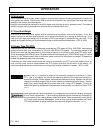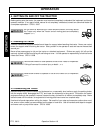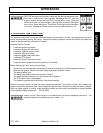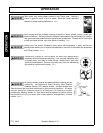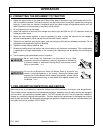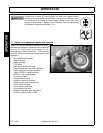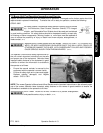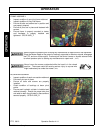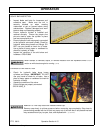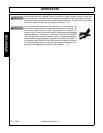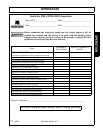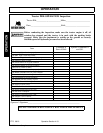
OPERATION
PT5 09/10 Operation Section 4-11
© 2010 Alamo Group Inc.
OPERATION
6. CONNECTING THE IMPLEMENT TO TRACTOR
1. Unbolt the upper halves of the yoke and fit them either side of the tractor’s top hitch bracket with the 3/4”
UNF nut and bolt provided. If the tractor has only one top hitch position, the bolt will replace the existing top
hitch pin. If more than one location is available mount the yokes through an alternative position as it will
make it easier to put the machine on and take it off the tractor.
2. Do not tighten the nut at this stage.
3. Attach the machine to the three point linkage and raise to give 200-250 mm (8”-10”) clearance under the
lowest part of the frame.
4. Rebolt the yoke halves together. It may be necessary to raise or lower the machine on the linkage to
achieve hole alignment. Adjust the top link until the main frame is vertical.
5. Tighten the nut and bolt securing the upper yoke just enough to eliminate any sideways movement. Do not
overtighten and squeeze the top hitch brackets
6. Tighten the check chains/ stabilizer bars.
7. Release its holding chain and position the control valve to suit the tractor and operator. This is achieved by
a combination of height adjustments in the mounting bar attachment and by bending the mounting bar
itself.
8. Turn the parking leg upside down and pin in position.
Never work under the Implement, the framework, or any lifted
component unless the Implement is securely supported or blocked up
to prevent sudden or inadvertent falling which could cause serious
injury or even death.
(SG-14)
Do not let the Blades turn when the Mower Deck is raised for any
reason, including clearance or for turning. Raising the Mower deck
exposes the Cutting Blades which creates a potentially serious hazard
and could cause serious injury or even death from objects thrown from
the Blades.
(SRM-07)
7. PRE-OPERATION INSPECTION AND SERVICE
Before each use, a pre-operation inspection and service of the implement and tractor must be performed.
This includes routine maintenance and scheduled lubrication, inspecting that all safety devices are equipped
and functional, and performing needed repairs. DO NOT operate the unit if the pre-operation inspection
reveals any condition affecting safe operation. Perform repairs and replacement of damaged and missing
parts as soon as noticed. By performing a thorough pre-operation inspection and service, valuable down time
and repair cost can be avoided. OPS-U-0029



